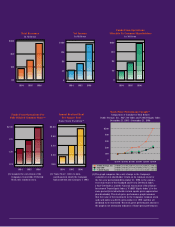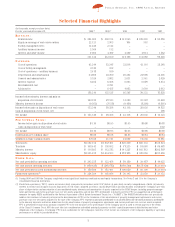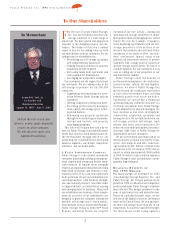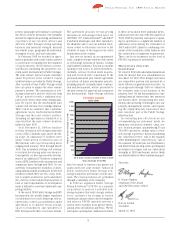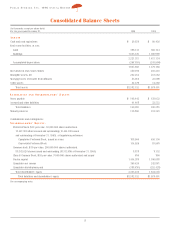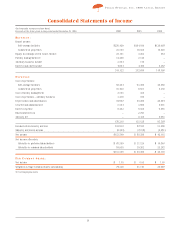Public Storage 1996 Annual Report Download - page 5
Download and view the complete annual report
Please find page 5 of the 1996 Public Storage annual report below. You can navigate through the pages in the report by either clicking on the pages listed below, or by using the keyword search tool below to find specific information within the annual report.
3
P
UBLIC
S
TORAGE
, I
NC
. 1996 A
NNUAL
R
EPORT
upgraded our credit rating, reducing our cost
of new capital. The merger significantly
reduced internal conflicts inherent in the
separate advisor/property manager format.
Institutional investor interest in our corpora-
tion has improved. We believe we experi-
enced numerous positives from the merger
throughout 1996 and expect this direction to
be maintained in the future.
C
APITALIZING
O
N
E
STABLISHED
C
OMPETITIVE
S
TRENGTHS
We believe that Public Storage possesses
strengths which are difficult for our competi-
tors to reproduce. These include:
•Strong operating business
•Financial strength
•Trade name
•Market share
•Geographic diversification
•Management
Strong operating business.
Funds from
operations (FFO) per common share is con-
sidered a key measure of the performance of
Public Storage. FFO per common share
advanced 14 percent, from $1.73 per share for
the year ended December 31, 1995, to $1.98
per share for the year ended December 31,
1996. We are adding to shareholder value by
practicing a conservative approach to distri-
butions. Retaining a substantial portion of
funds from operations (after funding Public
Storage’s distributions and capital improve-
ments) enables us to acquire and develop
properties and reduce debt using internal
cash resources. In this regard, Public Storage
differs significantly from its competitors, a
difference we believe is a favorable factor in
our long-term business plans. We distributed
44 percent of FFO per common share for
1996 and 52 percent for 1995. Through our
relatively moderate payout ratio in 1996
we retained $71 million of free capital to
purchase and develop properties.
Occupancy levels have historically repre-
sented one of the simplest but most efficient
windows into the strength and success of our
business. They show the balance between the
forces of supply and demand and the effects
of our promotional activities. For the year
ended December 31, 1996, occupancy at the
self-storage properties on a Same Store
basis averaged 91.2 percent, compared
to 90.1 percent one year earlier. Same
Stores are the 951 mini-warehouses that
Public Storage has had an interest in since
January 1, 1993.
The amount of rent Public Storage collects
bears an important connection to occupancy
trends. To the extent feasible we try to
generate rising or high occupancy levels and
rising rental rates. Same Store average
annual realized rent represents the actual
revenue earned per occupied square foot
and is a more relevant measure than posted
rental rates. Same Store average annual
realized rent was $8.76 per square foot for
the year ended December 31, 1996, com-
pared to $8.40 per square foot for the same
period of 1995, an increase of 4.3 percent.
Same Store revenues equaled $445.6 million
for the year ended December 31, 1996, com-
pared to $422.9 million for the same period
one year earlier, an increase of 5.4 percent.
Financial strength.
We have a strong bal-
ance sheet. Total assets, total debt, and total
shareholders’ equity are barometers of our
balance sheet strength. As of December 31,
1996, Public Storage’s assets totaled approx-
imately $2.6 billion, a $635 million increase
from approximately $1.9 billion one year
earlier. Public Storage’s debt-to-equity ratio
was reduced from approximately 10 per-
cent at December 31, 1995 to 5 percent at
December 31, 1996. Low debt leverage in
conjunction with our access to capital should
position us to respond to investment oppor-
tunities in our industry. Shareholders’ equity
equaled $2.3 billion as of December 31, 1996,
approximately 41 percent greater than the
$1.6 billion reported one year earlier.
Public Storage’s common stock achieved
all-time highs during 1996. Public Storage
responded to its strong financial position dur-
ing 1996 by completing two separate pre-
ferred stock offerings, raising $260 million,
and two common stock offerings,
raising approximately $129 million.
In March 1997, Public Storage com-
pleted a common stock offering that
raised approximately $127 million.
Since January 1, 1993, Public
Storage has issued approximately
$1.022 billion of equity capital, the
proceeds of which were used to
reduce debt and acquire interests in
self-storage properties.
Public Storage completed eight merger
transactions with affiliates in 1996, acquiring
105 properties.
In December 1996, Public Storage and two
affiliates, Public Storage Properties XIV, Inc.,
and Public Storage Properties XV, Inc.,
agreed, subject to certain conditions, to
merge. Requirements for the mergers include
the approval by the shareholders of each of
the affiliates. If approved, the mergers are
expected to be completed during the first half
of 1997. These affiliates collectively own 31
self-storage properties and two business
parks. Public Storage currently owns about
one-third of the capital stock of each of these
affiliates and manages the properties. We are
continuing to evaluate transactions with
other affiliates whose properties are man-
aged by Public Storage.
From January 1, 1994 through Decem-
ber 31, 1996, Public Storage acquired, in
cash tender offers, limited partnership inter-
ests in partnerships of which Public Storage
is a general partner for an aggregate pur-
chase price of approximately $86 million.
These acquisitions are intended to reduce
minority interest in the long-term and increase
Public Storage’s ownership interest in its
current property portfolio.
Trade name.
Public Storage’s 1,064 self-
storage or self-storage/ business park combi-
nations operate under the most recognized
trade name in the self-storage industry. We
believe that this enables us to provide conti-
nuity from one rental experience to the next,
customers being able to expect the same
level of quality and professionalism regard-
less of which Public Storage property they
The industry’s most enduring icon.
Stock Performance
(1)
The value of the Company’s common stock
has increased, reflecting in part growth
opportunities in the Company’s business.
STOCK PRICE RANGE
High Low Close
1996
1st quarter $21
7
⁄
8
$18
7
⁄
8
$20
3
⁄
8
2nd quarter 21
1
⁄
2
19
3
⁄
8
20
5
⁄
8
3rd quarter 22
5
⁄
8
19
7
⁄
8
22
5
⁄
8
4th quarter 31
3
⁄
8
22
1
⁄
4
31
1995
1st quarter $17
1
⁄
8
$13
1
⁄
2
$17
2nd quarter 17
1
⁄
8
15
1
⁄
4
16
3
⁄
8
3rd quarter 18
3
⁄
4
16
3
⁄
8
18
5
⁄
8
4th quarter 19
3
⁄
4
17
3
⁄
8
19
(1) The common stock has been listed on the New
York Stock Exchange since October 19, 1984.
The ticker symbol is PSA.


